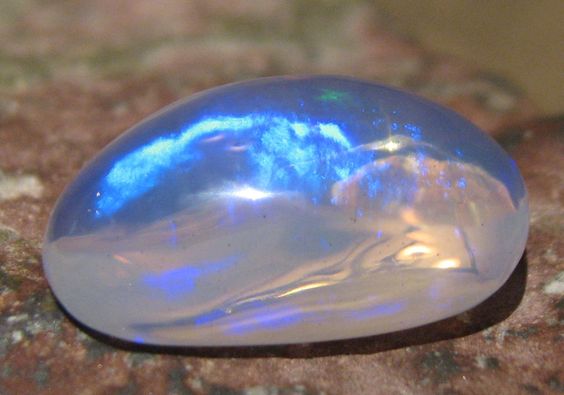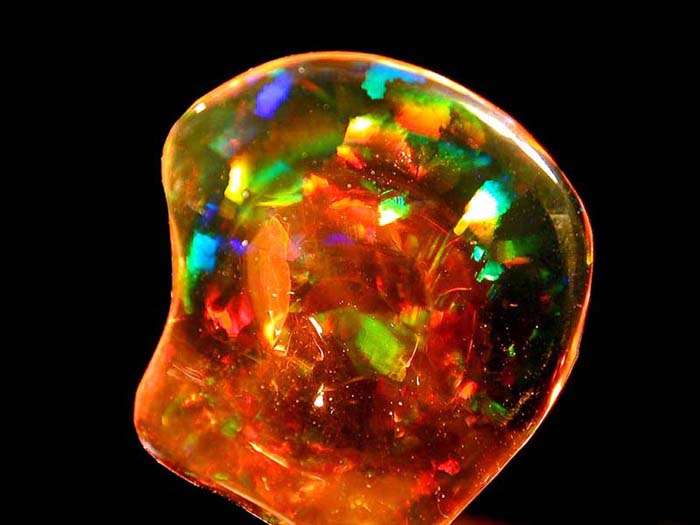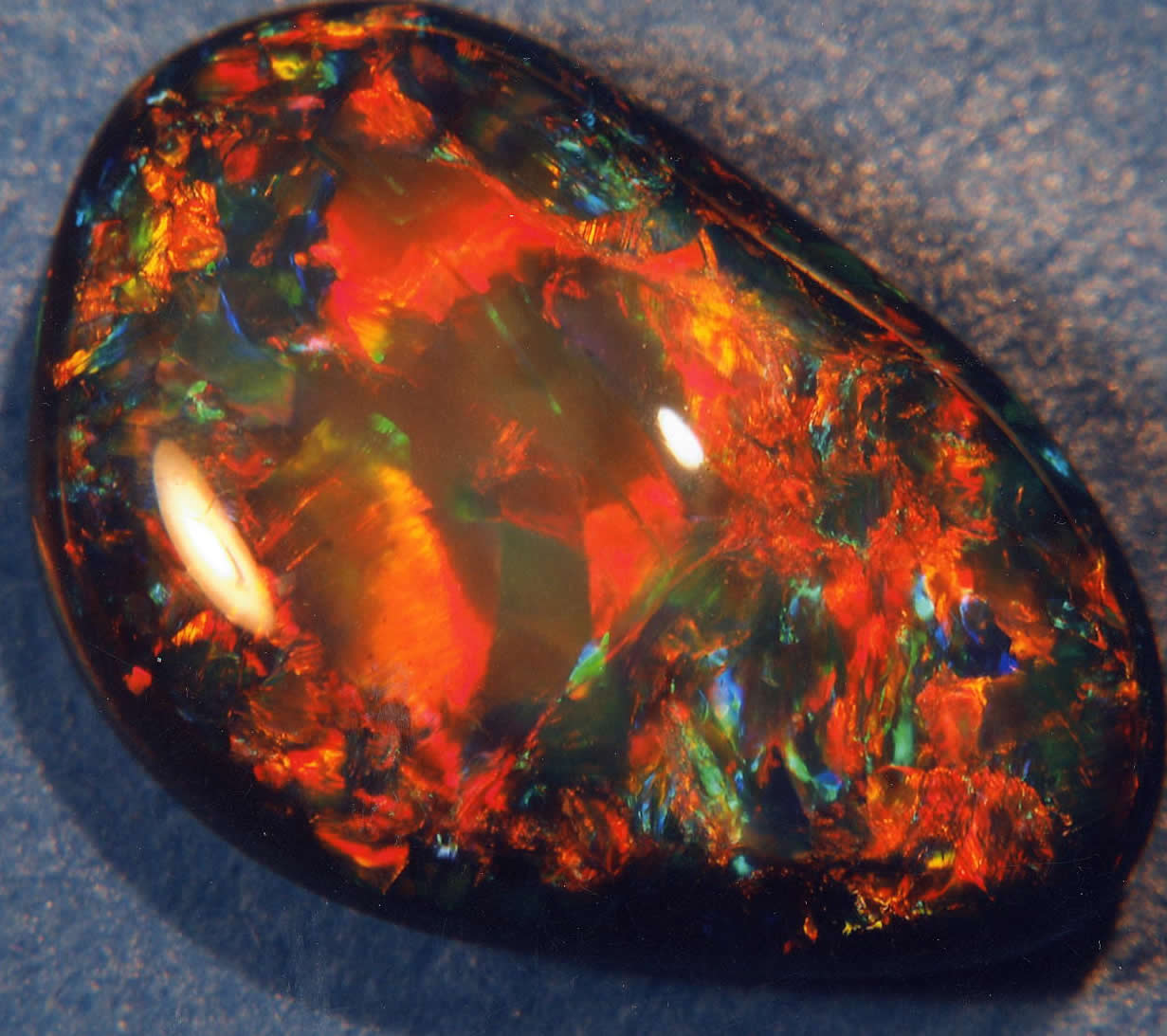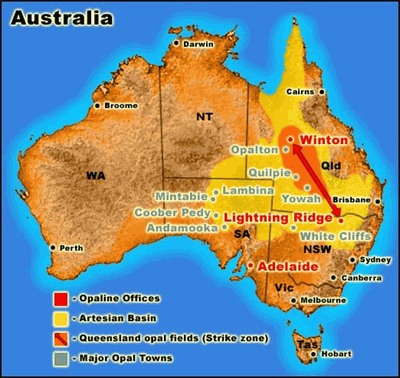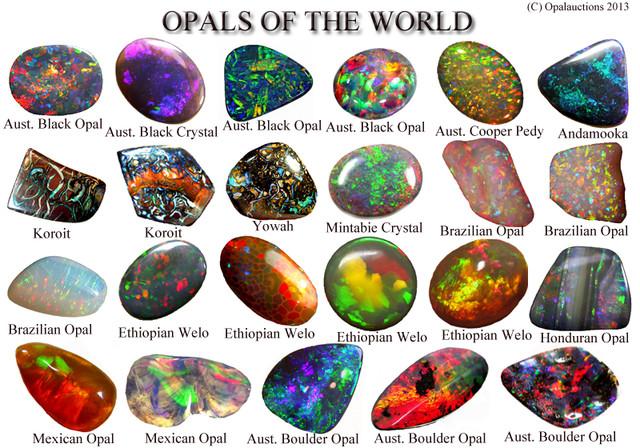Immersion into a saucerful of opals
Blue fire opal[edit | edit source]
Sunset fire opal[edit | edit source]
Red fire opal[edit | edit source]
Ethiopian Welo opal[edit | edit source]
This is an Ethiopian Welo Opal. It was just discovered in 2008. Inside of these opals seem to be a little world... You could lose yourself staring into one of these beauties. The Ethiopian opal is slightly different from the Australian opal. [5]
Opals of the world[edit | edit source]
|
|
The most important source of opal is Australia, which produces the most opal and the finest opal. The legendary locality for the best black opal is Lightning Ridge. The Burning of Troy[edit | edit source]This stunning black and red stone, with a hint of green at the very edges, is a stunning example of a high-quality black opal, and possibly affords a glimpse of what it must have been like to gaze upon the most glorious opal known to man at the turn of the 19th century. |
More in depth information on opal varieties (click here) [7]
Famous Opals[edit | edit source]
There are many famous Opals that have appeared throughout history. Some are famous for being the most valuable, some as the largest and others are famous for being associated with royalty. Keep reading to learn about the most famous Opals in history. [9]
Olympic Australis[edit | edit source]
(picture and information courtesy of Altmann & Cherny)
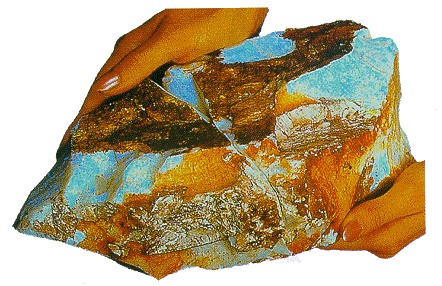
The "Olympic Australis" is reported to be the largest and most valuable gem opal ever found. It was found in 1956 at the famous "Eight Mile" opal field in Coober Pedy, South Australia. A miner working his claim found the opal at a depth of 30 feet. It was named in honor of the Olympic Games, which were being held in Melbourne at the time. This extraordinary opal consists of 99% gem opal with an even colour throughout the stone, and is one of the largest and most valuable opals ever found. The balance of 1% is the remaining soil still adhering to the stone. It weighs 17,000 carats (3450 grams) and is 11 inches long (280 mm), with a height of 4¾ inches (120 mm) and a width of 4½ inches (115 mm). It was valued at AUD$ 2,500,000 in 2005. Due to the purity of the opal it is anticipated that upwards of 7000 carats could be cut from the piece. However owing to it's uniqueness, the opal will remain exactly as found. [10]
Aurora Australis[edit | edit source]
(picture and information courtesy of Altmann & Cherny)
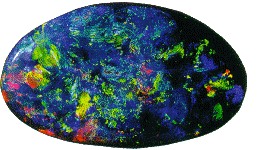
The "Aurora Australis" was found in 1938 at Lightning Ridge and is considered the world's most valuable black opal. The oval, cut and polished stone has a harlequin pattern with dominant red, green and blue colors against a black background. It weighs 180 cts. and is 3 inches by 1.8 inches. The rarity of the opal comes from its size and strong, vibrant colour play. It weighs 180 carats and its dimensions are 3 inches x 1.8 inches. Dug from an old sea-bed it has the distinctive impression of a star fish on its back. It was valued at AUD$ 1,000,000 in 2005.
The Aurora is the first large, fine, Australian opal mentioned in literature. Charlie Dunstan had found another large opal previously, but its blue-green colour play was not considered valuable at the time - although the stone weighed about 12 ounces (close to 1860 carats). At a depth of approximately six metres, Charlie found the brilliant gem. This treasure was rumored to have brought Dunstan 100 pounds. Altmann & Cherny purchased the opal in a semi-rough state (a rub). They cut and polished the opal into its oval shape, and realising what a true gem they had, they named it the "Aurora Australis" after the bright southern lights in the night sky. [10]
The Flame Queen[edit | edit source]
(pictures of The Flame Queen photographed at different angles)
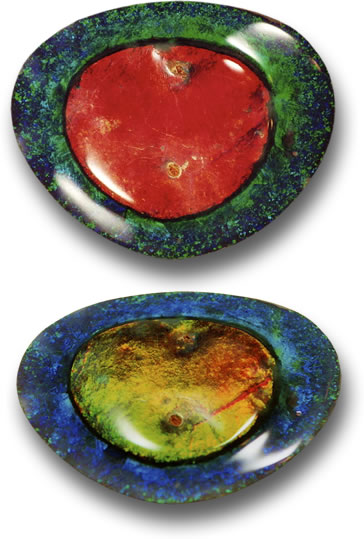
Perhaps the most famous opal in the world, the Flame Queen is the finest example of an "eye-of-opal", a magnificent opal with an eye-like appearance, which is caused when the opal forms by infilling a cavity.
The Flame Queen Opal is almost triangular in shape, measuring a whopping 70 mm x 63 mm x 12 mm, and weighing in at a staggering 263.18 carats (52.64g).
The polished, flat pear-shaped top of the Flame Queen Opal gives flashes of both fiery red and dynamic bronze, depending on the lighting and angle of view.
These bright, colorful shades are surrounded by a disc of deeper bluish-green, making this unique stone look somewhat like a fried egg in appearance.
The Flame Queen's extraordinary cut and shape enhance its appearance, allowing it to exhibit various other color combinations in different surroundings, making it such a unique and highly admired gem that it continues to attract worldwide attention as one of the rarest and most spectacular specimens of its kind.
The Flame Queen Opal was first discovered in 1914 at the Bald Hill workings at the charmingly named Lightning Ridge, New South Wales, Australia. It was found deep underground by miners Jack Philips, Walter Bradley and "Irish" Joe Hegarty, but it was almost never discovered at all.
At that time, Lightning Ridge had become a dangerous place to mine, with many miners deciding that the potential for opals there was no longer worth the risk involved. Even during earlier, more fruitful times, many desperate miners would often succumb to fatigue or illness in their quest to uncover the opal rich clay.
Philips, Bradley and Hegarty acquired the claim at Lightning Ridge after it was seemingly abandoned by a miner who left to fight in World War I. At first, their new mine seemed without value, as they dug their tunnel without any real success. Finally they reached a depth of 30 feet, which was typically regarded by opal miners in the area as the "make or break" point; this is the point at which typical opal levels are found, and at this point Philips, Bradley and Hegarty had nothing to show for their work, a sign indicating that there was no opal to be found.
Despite suspecting this claim was worthless, and perhaps in some desperation, the men continued to dig, with poor ventilation, almost no light, and an ever-growing risk of the tunnel collapsing (a tunnel less than 3 feet wide). Finally, against all odds, at a depth of around 35 feet, Bradley's pick struck a large, black opal nodule, and they excitedly dug farther, soon bringing their discovery to the surface. In the light of the sun, away from the dark, suffocating mine, they looked in amazement at their astonishing find.
It was Bradley who was entrusted to cut and polish this magnificent opal, due to his skill and knowledge of lapidary. He was said to have taken one crisp nick from the large black nodule with his steel snips, and immediately saw the dazzling reds and blue-green of the opal. But, despite his skilled work on the precious stone, its owners were now broke, tired and hungry, and as soon as it was cut and polished, the 263.18 carat Flame Queen Opal was sold for a measly £93.
The Flame Queen has since made many public appearances, most notably in an exhibition at the Geological Museum in London, in 1937, to honor the occasion of the coronation of King George VI.
The Flame Queen continues to be known and talked about around the world, due to its unique form and color, making it arguably the most famous opal in history. [11]

References[edit | edit source]
- ↑ https://it.pinterest.com/ccrystalblossom/crystals/
- ↑ https://www.flickr.com/photos/zircons/4287166465/in/set-72157623653908340
- ↑ http://www.harlequinminerals.co.uk/Graphics/Design%20photos/Min%20Pic%20Box%20-%20main%20Fr/Fire%20Opal%20%28polished%29-%20Mexico%20700.JPG
- ↑ http://www.venusbuzz.com/wp-content/uploads/red-opal.jpg
- ↑ http://www.viralnova.com/unique-beautiful-opals/
- ↑ http://www.roywmacdonald.com/Pages/Opalindepthinformation.aspx
- ↑ 7.0 7.1 http://www.roywmacdonald.com/Pages/Opal.aspx
- ↑ http://eragem.com/news/antique-celebrity-jewelry-empress-josephines-burning-of-troy-opal/
- ↑ http://www.macsopals.com/opal-guide/famous-historic-opals/
- ↑ 10.0 10.1 http://www.opalsdownunder.com.au/learn-about-opals/introductory/famous-opals
- ↑ http://www.gemselect.com/help/newsletter/newsletter-may-12.php
